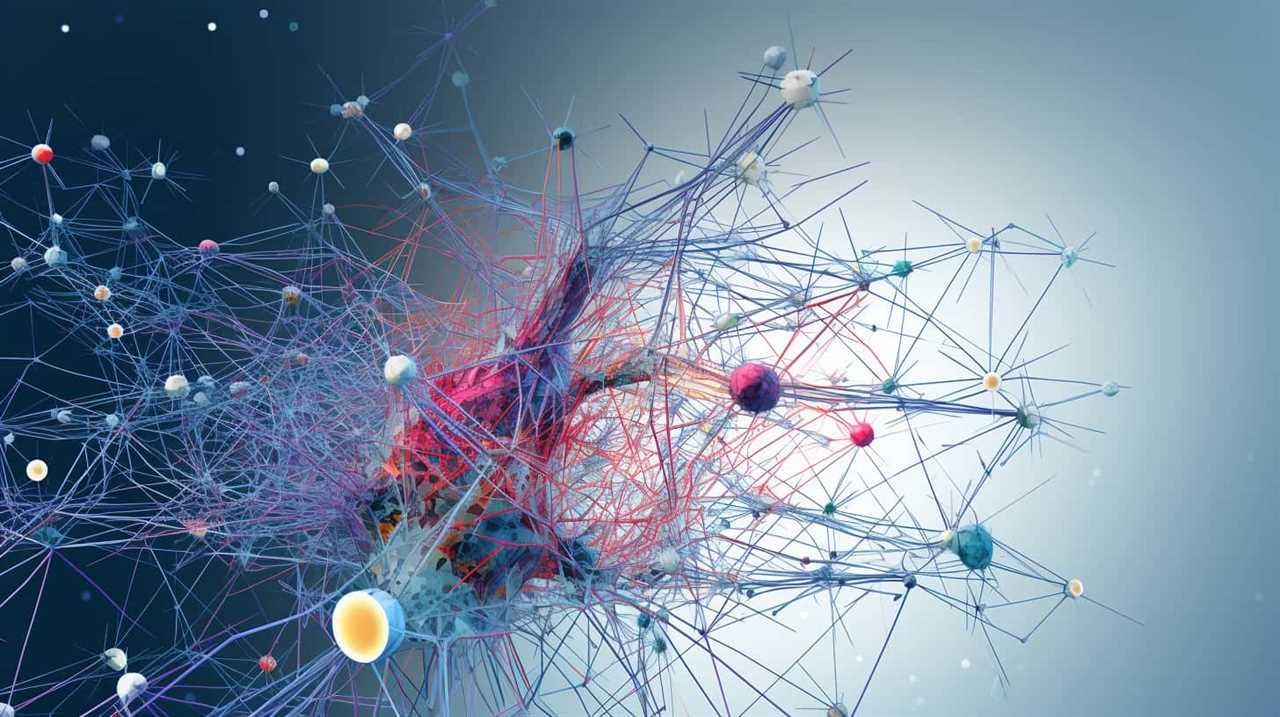AI in Business
AI Revolutionizes Astronomy: Unveiling the Cosmos’ Secrets

As someone deeply fascinated by astronomy, I have always been intrigued by the mysteries of the cosmos. The sheer size of the universe and the multitude of celestial bodies within it have consistently piqued my curiosity.
Now, with AI, a new era of astronomical research has dawned, revolutionizing how we uncover the secrets of the universe. AI’s algorithms assist in analyzing massive amounts of data, identifying patterns, anomalies, and potential discoveries.
Join me as we delve into the fascinating world where AI and astronomy intersect, unveiling the cosmos’ secrets like never before.
Key Takeaways
- AI algorithms can analyze large amounts of data from telescopes and satellites, leading to more efficient research.
- AI can detect faint signals and subtle patterns that may be missed by human astronomers, enhancing the accuracy and reliability of astronomical observations.
- AI has the potential to revolutionize how we explore and understand the universe, optimizing telescope operations and aiding in the development of autonomous space probes.
- Collaboration between AI and human astronomers can lead to more accurate and insightful discoveries, with AI assisting in automating repetitive tasks and allowing astronomers to focus on more complex research.
AI in Astronomy: An Overview
How does AI revolutionize astronomy and what role does it play in uncovering the secrets of the cosmos?

AI in astronomy has transformed the way we explore and understand the universe. One of the key applications of AI is in assisting telescope operations. AI algorithms can optimize data collection processes, improving efficiency and accuracy.
Additionally, AI plays a crucial role in the analysis of astrophysical simulations. These simulations generate vast amounts of complex data, which AI algorithms can efficiently analyze and interpret, aiding in the understanding of cosmic phenomena.
By leveraging AI, astronomers can uncover hidden patterns, identify new discoveries, and enhance our understanding of the cosmos.
The integration of AI in telescope operations and the analysis of astrophysical simulations has revolutionized the field of astronomy, enabling us to delve deeper into the mysteries of the universe.

AI Algorithms and Data Analysis
Analyzing data with AI algorithms is a game-changer in revolutionizing astronomy. AI algorithms in data analysis have the potential to significantly improve accuracy and efficiency in astronomical research. These algorithms play a crucial role in data-driven discoveries by unveiling hidden patterns and insights that may not be discernible to human astronomers.
AI can process vast amounts of data from telescopes and satellites much faster than humans, enabling more efficient research. It can detect faint signals and subtle patterns that may be overlooked by human astronomers, enhancing the accuracy and reliability of astronomical observations.
Additionally, AI algorithms can assist in categorizing and classifying astronomical objects, contributing to a deeper understanding of the cosmos.
Identifying Exoplanets and Gravitational Waves
AI algorithms in data analysis continue to revolutionize astronomy by identifying exoplanets and gravitational waves. The applications of AI in exoplanet research and advancements in gravitational wave detection have opened up new avenues for exploration and understanding of the cosmos.

Here are three key ways in which AI is transforming these fields:
- AI in exoplanet research: AI algorithms can analyze vast amounts of data from telescopes and satellites to identify potential exoplanets. By detecting subtle changes in starlight or gravitational influence, AI can help astronomers discover new exoplanets and study their characteristics.
- AI advancements in gravitational wave detection: Gravitational waves, ripples in spacetime caused by massive cosmic events, are challenging to detect. AI algorithms can sift through massive data sets to identify these faint signals, enabling astronomers to study the nature of black holes, neutron stars, and other astrophysical phenomena.
- Enhanced data analysis and interpretation: AI algorithms can assist in processing and interpreting the complex data generated by telescopes and detectors. By analyzing patterns and anomalies, AI can provide valuable insights into the nature of exoplanets and gravitational waves, pushing the boundaries of astronomical understanding.
With AI’s assistance, astronomers can unlock the secrets of the universe and gain deeper insights into the celestial phenomena that surround us.
Categorizing and Classifying Astronomical Objects
Continuing the exploration of AI in astronomy and its impact on identifying exoplanets and gravitational waves, a key aspect of this revolution is the categorization and classification of astronomical objects.
AI plays a crucial role in automating classification in astronomical surveys. With its ability to analyze vast amounts of data, AI algorithms can efficiently categorize and classify various celestial objects, such as stars, galaxies, and nebulae. By identifying patterns, shapes, and spectral characteristics, AI can accurately differentiate between different types of astronomical objects.

This automated classification process not only saves time but also enhances the accuracy and reliability of astronomical research.
AI in astronomical surveys has the potential to uncover new insights and discoveries by efficiently organizing and categorizing the vast amount of data collected by telescopes and satellites.
Faster Data Processing With AI
With the growing prevalence of AI in astronomy, data processing is now happening at a faster pace, allowing for more efficient analysis of the vast amount of data collected by telescopes and satellites. AI-powered advancements in data analysis have revolutionized the field by optimizing telescope operations and data collection processes.
Here are three key ways in which AI has improved data processing in astronomy:

- Increased Speed: AI algorithms can process data much faster than humans, enabling quicker analysis and reducing the time required for research.
- Enhanced Accuracy: AI algorithms can detect faint signals and subtle patterns that may be missed by human astronomers, leading to more accurate observations and measurements.
- Improved Efficiency: AI can automate repetitive and time-consuming tasks, freeing up astronomers to focus on more complex research and enabling them to explore a wider range of astronomical phenomena.
Detecting Faint Signals and Subtle Patterns
As an astronomer leveraging AI technology, I can now detect faint signals and subtle patterns in the cosmos, allowing for a more comprehensive understanding of celestial phenomena.
AI applications play a crucial role in detecting gravitational waves, which are minute ripples in the fabric of spacetime caused by cataclysmic cosmic events. By analyzing vast amounts of data collected by gravitational wave detectors, AI algorithms can identify these faint signals that would otherwise be challenging to detect.
Additionally, AI plays a significant role in optimizing space exploration missions. It can analyze complex data from satellites and probes, helping to identify subtle patterns that may indicate the presence of undiscovered celestial objects or phenomena. This enables astronomers to make more informed decisions and maximize the scientific value of their missions.
Identifying Rare and Unique Astronomical Events
Building on my previous discussion of detecting faint signals and subtle patterns in the cosmos, I now delve into the realm of identifying rare and unique astronomical events. With the advent of AI-enabled telescopes, the impact of AI on cosmology research has been profound. Here are three ways in which AI is revolutionizing the identification of rare and unique astronomical events:

- Improved Data Analysis: AI algorithms can analyze vast amounts of data from telescopes and satellites, enabling the identification of rare events that might’ve otherwise gone unnoticed.
- Pattern Recognition: AI algorithms excel at identifying patterns and anomalies. This capability allows astronomers to identify unique celestial phenomena, such as the discovery of new exoplanets or the detection of gravitational waves.
- Event Categorization: AI can assist in categorizing and classifying astronomical objects, aiding in the identification of rare events and enabling more accurate and efficient analysis.
With AI’s assistance, astronomers can now unravel the mysteries of the universe more effectively, unveiling rare and unique astronomical events that were previously hidden from our view.
Enhancing Accuracy and Reliability of Observations
Now, delving deeper into the realm of enhancing accuracy and reliability of observations, I explore how AI continues to revolutionize astronomy by improving the precision of astronomical measurements.
AI has made significant advancements in observations by improving data analysis techniques. With AI algorithms, astronomers can analyze vast amounts of data with greater efficiency and accuracy. These algorithms can detect subtle patterns and anomalies that may be missed by human observers, leading to the identification of rare and unique astronomical events.
AI also aids in the categorization and classification of astronomical objects, providing astronomers with a more comprehensive understanding of the cosmos.

Predicting and Modeling Complex Phenomena
To further advance our understanding of the cosmos, AI revolutionizes astronomy by accurately predicting and modeling complex phenomena. AI algorithms have the ability to analyze vast amounts of data and simulate cosmic events with remarkable precision.
Here are three ways AI is transforming the field:
- Predicting Celestial Events: By analyzing historical data and patterns, AI algorithms can forecast the occurrence of celestial events such as supernovae, meteor showers, and eclipses. This not only aids in planning observations but also provides valuable insights into the behavior of astronomical phenomena.
- Simulating Cosmic Phenomena: AI can simulate complex astrophysical processes, such as the formation of galaxies, evolution of stars, and dynamics of black holes. These simulations enable astronomers to explore scenarios that are difficult to observe directly and contribute to our understanding of the universe’s evolution.
- Enhancing Model Accuracy: AI algorithms can refine theoretical models by comparing simulations with observational data. This iterative process improves the accuracy and reliability of models, allowing astronomers to make more precise predictions and validate existing theories.
Through its predictive capabilities and simulation prowess, AI opens up new avenues for unraveling the secrets of the cosmos.
Training Data and Algorithm Performance
One key aspect in the revolution of AI in astronomy is the importance of training data and its impact on algorithm performance.

AI algorithms require large amounts of training data to perform accurately. However, the quality and reliability of the training data can significantly impact the performance of AI algorithms.
One challenge that arises in the context of training data is the potential for bias. If the training data is biased, it can lead to biased results and inaccurate predictions. Therefore, it’s crucial to ensure that the training data is diverse, representative, and free from any bias.
Additionally, continuous improvement of AI algorithms is necessary to keep up with advancements in astronomy. As new discoveries are made and our understanding of the cosmos evolves, AI algorithms need to be updated and refined to ensure their accuracy and reliability in analyzing astronomical data.
Addressing Potential Errors in Research
Moving forward from the importance of training data and its impact on algorithm performance, let’s now delve into addressing potential errors in research within the field of AI in astronomy.

- Addressing bias in data analysis: One of the key challenges in using AI algorithms in astronomy is the potential for bias in data analysis. It’s essential to evaluate and mitigate any biases that may arise from the training data or algorithm design. This can be done through careful selection and preprocessing of the data, as well as regularly monitoring and updating the algorithms to ensure fairness and accuracy.
- Evaluating the limitations of AI algorithms in astronomy: While AI algorithms have shown great promise in astronomy, they also have their limitations. It’s crucial to assess the capabilities and reliability of these algorithms in different scenarios and to be aware of their potential weaknesses. This evaluation process involves rigorous testing, validation, and comparison with existing methods to understand the boundaries of AI algorithms and identify areas where human expertise is still necessary.
Ethical Considerations in AI and Astronomy
My ethical concerns arise when considering the potential for bias in data analysis in AI and astronomy.
While AI algorithms have the capability to process large amounts of data and identify patterns, anomalies, and potential discoveries, there’s a risk of introducing biases into the analysis. The quality and reliability of the training data used to develop these algorithms can significantly impact their performance and accuracy. If the training data is biased or incomplete, it can lead to false positives or false negatives, potentially distorting the findings and conclusions drawn from the data.
It’s crucial to ensure that the training data used is representative and unbiased to minimize these ethical implications. Additionally, continuous monitoring, updates, and improvements to AI algorithms are necessary to mitigate biases and align with advancements in astronomy.
Future Applications of AI in Space Exploration
The future applications of AI in space exploration hold immense potential for revolutionizing our understanding of the cosmos.

- Optimizing Space Exploration: AI can be utilized to optimize telescope operations and data collection processes, enabling more efficient and targeted observations. This can lead to a greater volume of high-quality data being collected and analyzed.
- Autonomous Space Probes: AI can contribute to the development of autonomous space probes, enabling them to make intelligent decisions and carry out tasks without human intervention. This autonomy can greatly enhance the efficiency and effectiveness of space exploration missions.
- Search for Extraterrestrial Intelligence: AI can play a crucial role in the search for extraterrestrial intelligence by analyzing vast amounts of data from radio telescopes and satellites. It can help identify potential signals or patterns that could indicate the presence of intelligent life beyond Earth.
Collaboration Between AI and Human Astronomers
An essential aspect of the collaboration between AI and human astronomers is the utilization of a vast amount of training data. AI algorithms require extensive datasets to learn and make accurate predictions in astronomy.
By leveraging this training data, AI can assist human astronomers in maximizing their discoveries. However, this collaboration also presents ethical challenges. Bias in data analysis is a concern, as AI algorithms can inadvertently perpetuate biases present in the training data. Therefore, it’s crucial for human astronomers to guide and interpret the results obtained by AI.
This collaboration aims to augment human intelligence with AI capabilities, allowing for more accurate and insightful discoveries in astronomy. By automating repetitive tasks, AI enables astronomers to focus on more complex research, ultimately driving groundbreaking advancements in the field.
Frequently Asked Questions
How Can AI Algorithms Assist in the Search for Extraterrestrial Intelligence and the Detection of Potential Signals?
AI algorithms play a crucial role in the search for extraterrestrial intelligence (SETI) and the detection of potential signals. These algorithms can analyze vast amounts of data collected from telescopes and satellites, scanning for patterns and anomalies that may indicate the presence of intelligent life.

What Are Some Potential Ethical Concerns That Arise When Using AI in Astronomy?
Ethical concerns and privacy issues can arise when using AI in astronomy. AI algorithms rely on large amounts of training data, which can introduce bias into the analysis. There’s a risk of false positives or false negatives, leading to potential errors in research.
Additionally, the use of AI raises questions about data privacy and security. It’s important to address these concerns and ensure transparency in the use of AI in order to maintain the integrity and trust in astronomical research.
How Can AI Optimize Telescope Operations and Data Collection Processes?
To optimize telescope operations and data collection processes, AI applications can revolutionize the way we observe the cosmos. By leveraging AI-driven algorithms, telescopes can be automated to efficiently scan the sky, identify interesting targets, and prioritize observations.
AI can also assist in real-time data analysis, enabling the identification of rare events and phenomena. This not only saves time but also ensures that no valuable data is missed.

With AI, telescope operations and data collection can be streamlined, leading to more productive and insightful astronomical research.
In What Ways Can AI Contribute to the Analysis of Complex Astrophysical Simulations and Theoretical Models?
AI driven data analysis and machine learning applications can greatly contribute to the analysis of complex astrophysical simulations and theoretical models. By analyzing vast amounts of data, AI algorithms can identify patterns and correlations that may not be easily discernible to human astronomers.
This can lead to a deeper understanding of the underlying physics and mechanisms at work in the universe. Additionally, AI can help refine and validate theoretical models by comparing them to observed data, further advancing our knowledge of the cosmos.
How Does Collaboration Between AI and Human Astronomers Lead to More Accurate and Insightful Discoveries in Astronomy?
Collaboration between AI and human astronomers leads to more accurate and insightful discoveries in astronomy. By combining the power of AI algorithms with human expertise, we can achieve collaborative advancements that enhance our understanding of the cosmos.

AI assists in automating repetitive tasks, allowing astronomers to focus on more complex research. The synergy between AI and human intelligence uncovers new insights, pushes the boundaries of our knowledge, and ultimately revolutionizes our understanding of the universe.
Conclusion
In the vast expanse of the cosmos, AI has emerged as a powerful ally in unraveling its mysteries. Like a cosmic key, AI unlocks hidden patterns and anomalies, guiding us towards new discoveries.
Though challenges remain, collaboration between AI and human astronomers will propel us further into the depths of space, where we’ll continue to uncover the secrets that the universe holds.
Together, we stand on the precipice of a new era of astronomical exploration, fueled by the boundless potential of artificial intelligence.

AI in Business
Unlock Success with Predictive Analytics for Small Business

In today’s fast-paced business environment, it is essential for small businesses to stay ahead of their competitors in order to succeed. These small companies require powerful tools that can quickly analyze large amounts of data and produce precise predictions, allowing them to make well-informed decisions and stimulate growth. Predictive analytics, combined with artificial intelligence, fulfills this vital role.
At [YourCompany], we understand the importance of leveraging advanced analytics to unlock your small business’s full potential. Our predictive analytics solutions are specifically designed to cater to the unique needs of small businesses, providing you with valuable insights for future business strategies.
Key Takeaways:
- Predictive analytics, powered by artificial intelligence, enables small businesses to make informed decisions and drive growth.
- By analyzing large amounts of data quickly, predictive analytics generates accurate predictions and valuable insights for future business strategies.
- [YourCompany]’s predictive analytics solutions are tailored to meet the unique needs of small businesses, empowering them to stay ahead of the competition.
- Unlock your small business’s full potential by leveraging advanced analytics and embracing the power of predictive analytics.
- Stay tuned for the upcoming sections to dive deeper into the role of AI in predictive analytics, the benefits it offers, and how it can transform your small business.
Understanding the Role of AI in Predictive Analytics
AI predictive analytics plays a crucial role in harnessing the power of data for small businesses. By incorporating artificial intelligence into predictive analytics, businesses can leverage AI models to analyze data, generate accurate predictions, and derive valuable insights. With the help of algorithms, AI models can quickly process large amounts of data, enabling businesses to make predictions based on millions of data points within minutes. This allows small businesses to stay ahead of the competition by making data-driven decisions and uncovering trends that may not be apparent through traditional data analysis methods.
AI models are the driving force behind data analysis in predictive analytics. These models utilize sophisticated algorithms to interpret and make sense of vast amounts of data, uncovering patterns, correlations, and trends that can provide valuable insights. By understanding how AI models analyze and interpret data, small businesses can gain a deeper understanding of their operations, customer behavior, and market trends. This knowledge can empower businesses to optimize their strategies, improve operational efficiency, and enhance their decision-making process.
Predictive analytics, powered by AI, holds the key to unlocking accurate predictions and driving meaningful business insights. By leveraging data analysis techniques, algorithms, and AI models, small businesses can harness the power of predictive analytics to gain a competitive edge in today’s data-driven world.
Understanding the Role of AI in Predictive Analytics
| Benefits of AI in Predictive Analytics | Components of AI Predictive Analytics |
|---|---|
|
|
The Benefits of AI Predictive Analytics
Adopting AI predictive analytics offers several benefits to small businesses. It enables better decision-making by providing accurate insights and predictions based on comprehensive data analysis. With AI, we can generate accurate predictions quickly, allowing us to make informed decisions that drive growth. By leveraging AI models and algorithms, we can process large amounts of data efficiently, saving valuable time and resources. This increased efficiency allows us to focus on strategic initiatives and drive productivity.
AI predictive analytics also helps enhance customer experiences by enabling personalized marketing campaigns and tailored product offerings. By analyzing customer data, such as purchase history and browsing behavior, we can gain a deeper understanding of their preferences and needs. This allows us to deliver targeted marketing messages and create personalized experiences that increase customer satisfaction and loyalty. With AI predictive analytics, we can build stronger relationships with our customers and differentiate ourselves from the competition.
“AI predictive analytics reduces the risk of making uninformed decisions by providing data-driven recommendations. By analyzing historical data and market trends, we can anticipate shifts and make proactive adjustments to our strategies. This risk mitigation allows us to navigate uncertainties and make smarter choices that minimize potential losses.”
Reducing risk is another significant advantage of AI predictive analytics. By analyzing historical data and market trends, we can identify potential risks and make proactive adjustments to our strategies. This data-driven approach helps us minimize potential losses and navigate uncertainties effectively. By leveraging AI predictive analytics, we can make informed decisions that reduce risk and increase the likelihood of business success.
Key Benefits of AI Predictive Analytics:
- Better decision-making based on accurate insights and predictions
- Increased efficiency through quick data analysis and processing
- Enhanced customer experiences through personalized marketing and tailored product offerings
- Reduced risk by providing data-driven recommendations
| Benefits | Descriptions |
|---|---|
| Better Decision-Making | AI predictive analytics provides accurate insights and predictions, enabling informed decision-making. |
| Increased Efficiency | AI models and algorithms can process large amounts of data quickly, improving efficiency. |
| Enhanced Customer Experiences | Personalized marketing and tailored product offerings improve customer satisfaction and loyalty. |
| Reduced Risk | Data-driven recommendations help mitigate risks and navigate uncertainties. |
By embracing AI predictive analytics, small businesses can unlock the benefits of better decision-making, increased efficiency, enhanced customer experiences, and reduced risk. These advantages propel business growth and position us for success in today’s competitive landscape. As we continue to harness the power of AI and data analytics, we can make strategic decisions that drive our business forward and ensure long-term sustainability.
Industries Leveraging AI Predictive Analytics
Various industries are harnessing the power of AI predictive analytics to drive growth and enhance their operations. Let’s explore how healthcare, finance, marketing and sales, and customer service are leveraging this cutting-edge technology.
Healthcare
In the healthcare industry, AI predictive analytics is revolutionizing patient care. Doctors can use predictive models to improve diagnoses and treatment plans. By analyzing patient data, such as medical history, lab results, and symptoms, AI algorithms can provide insights that help physicians make accurate predictions and informed decisions. This enables healthcare professionals to deliver personalized treatment options and improve patient outcomes.
Finance
In the finance industry, AI predictive analytics is instrumental in financial analysis and market predictions. Financial institutions leverage AI models to analyze vast amounts of data, including market trends, historical performance, and customer behavior. This helps them identify investment opportunities, forecast market fluctuations, and manage risks effectively. By utilizing predictive analytics, financial institutions can make data-driven decisions that optimize their profitability and drive business growth.
Marketing and Sales
Marketing and sales teams rely on AI predictive analytics to develop targeted campaigns and optimize customer engagement. By analyzing customer data, such as purchase history, demographics, and online behavior, AI algorithms can identify patterns and preferences. This allows businesses to tailor marketing messages, optimize pricing strategies, and deliver personalized experiences to customers. By leveraging predictive analytics, marketing and sales professionals can enhance customer acquisition, retention, and overall satisfaction.
Customer Service
In the realm of customer service, AI predictive analytics plays a vital role in providing personalized experiences and improving satisfaction. By analyzing customer data, such as past interactions, preferences, and sentiment analysis, businesses can anticipate customer needs and proactively address issues. This enables customer service teams to provide tailored support, recommend relevant products or services, and deliver exceptional customer experiences. AI predictive analytics empowers businesses to build strong customer relationships and foster loyalty.
These industries are just a few examples of how AI predictive analytics is transforming businesses. By harnessing the power of data and AI, organizations can unlock valuable insights, drive informed decision-making, and gain a competitive edge in today’s digital landscape.
The Importance of Data in Predictive Analytics
Data is the foundation of any successful predictive analytics strategy. Without quality data, businesses cannot effectively analyze trends, identify patterns, or make data-driven decisions. Collecting and analyzing data provides valuable insights that drive business growth and inform strategic decision-making processes.
By leveraging data, businesses can uncover hidden correlations, spot emerging market trends, and gain a deeper understanding of customer behavior. These insights enable businesses to make informed decisions based on evidence rather than guesswork, which is crucial in today’s competitive landscape.
The Power of Insights
Insights gained from data analysis can shape every aspect of a business, from product development and marketing strategies to operational efficiencies and customer experiences. For example, analyzing customer data can help businesses personalize marketing messages, offer tailored product recommendations, and improve overall customer satisfaction.
Data-driven decision making is not only important for individual businesses but also for the overall industry. By analyzing industry-wide data, businesses can identify trends and shifts that impact their sector, enabling them to adapt and stay ahead of the competition.
Ultimately, data-driven decision making is a game-changer for small businesses. It allows them to optimize operations, enhance customer experiences, and drive sustainable growth. Embracing data as a valuable asset is essential for long-term success in an increasingly data-centric world.
| Benefits of Data in Predictive Analytics | Examples |
|---|---|
| Better decision-making | Analyzing customer data to personalize marketing campaigns and improve product offerings |
| Enhanced operational efficiencies | Identifying bottlenecks and streamlining processes based on data insights |
| Improved customer experiences | Utilizing customer data to provide personalized services and tailored experiences |
| Adaptation to market trends | Using industry-wide data to identify shifts and make informed business strategies |

Defining Key Performance Indicators (KPIs) for Data Analysis
When it comes to data analysis, identifying and tracking Key Performance Indicators (KPIs) is essential for small businesses. KPIs are quantifiable metrics that provide insights into various aspects of business performance. By defining the right KPIs, businesses can align their data analysis efforts with their overall strategic goals and focus on areas that contribute to their growth.
There are several key steps to defining KPIs for effective data analysis. First, businesses need to identify their specific business goals. Whether it’s improving customer satisfaction, increasing operational efficiency, or driving sales, having a clear understanding of the desired outcomes will help determine which metrics to track.
Once the goals are established, the next step is selecting the relevant metrics that align with those goals. These metrics can vary depending on the nature of the business and the specific objectives. For example, if the goal is to improve customer satisfaction, metrics like customer retention rate, Net Promoter Score (NPS), or customer feedback ratings can be considered as KPIs.
It’s important to note that the chosen KPIs should be measurable, achievable, and relevant to the business objectives. Regular tracking and analysis of these metrics will provide valuable insights into performance trends, areas for improvement, and opportunities for growth. By focusing on the right KPIs, businesses can effectively harness the power of data analysis to make informed decisions and drive success.
Example: Key Performance Indicators for an E-commerce Business
| KPI | Metric |
|---|---|
| Conversion Rate | The percentage of website visitors who make a purchase |
| Average Order Value | The average value of each customer order |
| Customer Lifetime Value (CLV) | The predicted net profit from a customer over their entire relationship with the business |
| Cart Abandonment Rate | The percentage of customers who add items to the cart but do not complete the purchase |
| Return Rate | The percentage of products returned by customers |
In this example, an e-commerce business might focus on tracking metrics like conversion rate, average order value, customer lifetime value (CLV), cart abandonment rate, and return rate to assess the success of their online sales efforts. These KPIs provide valuable insights into different aspects of the business, such as customer behavior, revenue generation, and overall customer satisfaction.
By defining and tracking relevant KPIs, businesses can gain a deeper understanding of their performance, identify areas for improvement, and make data-driven decisions to achieve their desired business outcomes.
Collecting and Analyzing Data for Predictive Analytics
Collecting and organizing data is a crucial step in harnessing the power of predictive analytics. It lays the foundation for generating valuable insights that can drive informed decision-making and fuel business growth. Small businesses can leverage various data collection tools and platforms to simplify the process and ensure accurate and comprehensive data acquisition.
Once the data is collected, employing data analysis techniques opens up a world of possibilities for extracting meaningful insights. Techniques such as visualizations and trend analysis allow businesses to identify patterns and correlations within the data, enabling them to make informed predictions and optimize their strategies. These insights can provide valuable guidance in understanding market trends, optimizing operations, and personalizing customer experiences.
To illustrate the importance of data analysis, let’s take a look at an example table:
| Month | Revenue | Website Traffic | Conversion Rate |
|---|---|---|---|
| January | $10,000 | 5,000 | 2% |
| February | $12,000 | 6,200 | 1.8% |
| March | $15,000 | 7,500 | 2.2% |
This table provides a snapshot of key metrics for three consecutive months. By analyzing this data, we can identify trends and insights. For instance, we can see that the revenue has been increasing month over month, indicating positive growth. Additionally, the conversion rate has fluctuated, suggesting potential opportunities for optimization. By delving deeper into this data and performing more extensive analysis, businesses can uncover valuable insights to inform strategic decision-making and drive growth.

Maximizing Insights through Data-driven Decision Making
Data collection and analysis enable businesses to make data-driven decisions, which have become increasingly essential in today’s competitive landscape. By using data to inform strategies and identify opportunities, small businesses can stay ahead of the curve and capitalize on emerging trends. It is crucial to continuously collect and analyze data to ensure that insights remain relevant and up-to-date. By adopting a data-driven approach, businesses can take calculated risks, optimize operations, and drive sustainable growth.
Identifying Patterns and Trends with Predictive Analytics
Predictive analytics allows us to dive deep into our historical data and uncover valuable patterns and trends. By analyzing our data, we can identify correlations and anticipate market shifts, giving us a competitive advantage in our industry. Let’s take a closer look at how predictive analytics can help us optimize our inventory management and refine our marketing strategies.
Optimizing Inventory Management
Understanding historical data can significantly improve our inventory management process. By analyzing past sales data, we can identify which products are popular during specific seasons or events. This insight allows us to adjust our inventory levels accordingly, minimizing the risk of overstocking or running out of stock. With predictive analytics, we can forecast demand accurately, ensuring that we always have the right products in stock and reducing costs associated with inventory management.
Refining Marketing Strategies
Market trends and consumer preferences are constantly evolving. To stay ahead of the competition, we need to adapt our marketing strategies accordingly. Predictive analytics enables us to analyze historical data to identify patterns in customer behavior, purchasing habits, and market trends. Armed with this knowledge, we can develop targeted marketing campaigns that resonate with our target audience. By tailoring our messages and offers to specific customer segments, we can increase customer engagement, drive conversions, and ultimately boost our revenue.
Key Takeaways
- Historical data analysis is crucial for identifying patterns and trends.
- Predictive analytics helps optimize inventory management and reduce costs.
- Analyzing market shifts enables us to refine our marketing strategies and drive revenue growth.
By leveraging the power of predictive analytics, we can make data-driven decisions that lead to business success. Whether it’s optimizing inventory management or refining marketing strategies, understanding historical data can give us a competitive edge in today’s fast-paced business environment.
Enhancing Customer Experiences with Predictive Analytics
In today’s competitive business landscape, customer satisfaction is a key driver of success. Small businesses are increasingly turning to predictive analytics to enhance customer experiences and gain a competitive edge. By leveraging data analysis and AI-powered models, businesses can personalize marketing efforts, optimize product offerings, and deliver tailored experiences that resonate with customers.
One of the primary benefits of predictive analytics is the ability to create personalized marketing campaigns. By analyzing customer data, businesses can gain insights into individual preferences and behaviors. This information allows for targeted messaging and offers that are more likely to capture the attention and interest of customers. Whether it’s a personalized email, a tailored recommendation, or a special promotion, predictive analytics enables businesses to engage customers on a more personal level, increasing the likelihood of conversion and fostering long-term loyalty.
“Predictive analytics allows us to better understand our customers and anticipate their needs. By analyzing data on past purchases, browsing behavior, and interactions with our brand, we can tailor our marketing messages to each individual. This personalized approach not only enhances the customer experience but also drives higher engagement and conversion rates.”
In addition to personalized marketing, predictive analytics also enables businesses to optimize their product offerings. By analyzing customer data and market trends, businesses can identify emerging preferences and adapt their offerings accordingly. This data-driven approach ensures that businesses are delivering products that are in line with customer demands, increasing the likelihood of satisfaction and repeat purchases. Whether it’s introducing new features, expanding product lines, or refining existing offerings, predictive analytics provides the insights needed to make informed decisions that drive customer satisfaction.
Overall, predictive analytics empowers small businesses to deliver exceptional customer experiences. By leveraging data and AI-powered models, businesses can personalize marketing efforts, optimize product offerings, and create tailored experiences that resonate with customers. In today’s customer-centric landscape, leveraging predictive analytics is essential for businesses looking to enhance customer satisfaction, increase loyalty, and drive sustainable growth.
Mitigating Risks and Improving Efficiency with Predictive Analytics
Predictive analytics is a powerful tool that small businesses can leverage to mitigate risks and improve operational efficiency. By analyzing financial data and market trends, businesses can proactively identify potential threats and make data-driven decisions to mitigate risks. This allows them to adjust strategies accordingly, ensuring they are well-prepared for any challenges that may arise.
Additionally, predictive analytics helps businesses optimize their operations and improve overall efficiency. By identifying bottlenecks and streamlining processes, businesses can eliminate inefficiencies and reduce costs. This not only enhances productivity but also frees up resources that can be allocated to other areas of the business, further driving growth and success.
Implementing predictive analytics also enables businesses to make data-driven decisions. By leveraging data insights and predictions, businesses can confidently make informed choices that align with their goals and objectives. This eliminates the reliance on guesswork and intuition, ensuring that decisions are based on concrete data and analysis.
To fully harness the power of predictive analytics, businesses need to prioritize data collection and analysis. By integrating advanced analytics tools and establishing robust data management processes, businesses can unlock the full potential of their data. This allows for more accurate predictions, comprehensive risk analysis, and improved overall performance.
Table: Examples of Risk Mitigation and Improved Efficiency with Predictive Analytics
| Risk Category | Predictive Analytics Application | Benefits |
|---|---|---|
| Market Volatility | Forecasting market trends and predicting shifts | Proactive decision-making, reduced financial loss |
| Supply Chain Disruptions | Analyzing historical data and identifying potential disruptions | Improved inventory management, minimized disruptions |
| Customer Churn | Identifying customer behavior patterns and predicting churn | Targeted retention strategies, increased customer loyalty |
| Operational Inefficiencies | Streamlining processes and identifying bottlenecks | Enhanced productivity, reduced costs |
By employing predictive analytics, small businesses can effectively mitigate risks, improve operational efficiency, and make data-driven decisions. This empowers them to navigate uncertainties, optimize their operations, and drive sustainable growth in today’s competitive business landscape.
Embracing a Data-Driven Culture for Business Success
In today’s digital age, data has become a valuable asset for businesses of all sizes. Small businesses, in particular, can greatly benefit from adopting a data-driven culture within their organization. By embracing data-driven decision making, fostering data literacy, utilizing data analysis tools, and cultivating an organizational culture that values data, small businesses can unlock their full potential and drive business success.
One of the key aspects of a data-driven culture is making decisions based on data rather than intuition or guesswork. This involves using data to gain insights, identify trends, and make informed decisions that align with business goals. By relying on data, small businesses can minimize risks, optimize operations, and seize growth opportunities.
Benefits of a Data-Driven Culture
A data-driven culture also involves developing data literacy within the organization. This means equipping employees with the skills and knowledge needed to effectively analyze and interpret data. By providing training and resources, small businesses can empower their employees to harness the full potential of data analysis tools and make data-driven decisions. This not only enhances the accuracy of decision making but also promotes a culture of continuous learning and improvement.
Implementing data analysis tools is another critical aspect of embracing a data-driven culture. These tools enable businesses to collect, organize, and analyze data in a structured and efficient manner. By leveraging data analysis tools, small businesses can uncover insights, identify patterns, and make data-driven decisions with greater ease and accuracy.
“Data-driven decision making is the key to unlocking business success in the digital age.”
Lastly, fostering an organizational culture that values data is crucial for sustained success. This involves creating an environment where data is seen as a strategic asset and is used to guide decision making at all levels of the organization. By prioritizing data-driven approaches and encouraging collaboration and transparency, small businesses can build a culture that fosters innovation, agility, and growth.
By embracing a data-driven culture, small businesses can position themselves for long-term success in an increasingly data-centric world. By making data-driven decisions, promoting data literacy, utilizing data analysis tools, and fostering an organizational culture that values data, small businesses can thrive and achieve sustainable growth.
| Data-Driven Culture Benefits | Explanation |
|---|---|
| Improved Decision Making | By leveraging data, businesses can make informed decisions that align with their goals. |
| Enhanced Efficiency | Data analysis tools streamline processes and optimize operations, leading to increased efficiency. |
| Competitive Advantage | A data-driven culture positions businesses ahead of competitors by leveraging data insights. |
| Innovation and Growth | Data-driven approaches foster innovation and drive business growth. |
Conclusion
At our company, we understand the importance of data analytics for small businesses in driving sustainable business growth. Predictive analytics, powered by artificial intelligence, provides small businesses with powerful tools to make informed decisions and unlock their growth potential.
By leveraging data and employing AI models, small businesses can gain valuable insights and predictions that help them make better decisions and drive their business forward. Predictive analytics not only enhances decision-making but also enhances customer experiences, mitigates risks, and improves operational efficiency.
Embracing a data-driven approach and fostering a culture of analytics is crucial in today’s digital age. Small businesses that recognize the power of predictive analytics and invest in data analysis will have a competitive advantage in their respective industries. By using data analytics as a foundation for business strategies, small businesses can achieve sustainable growth and stay ahead in the market.
Ultimately, data analytics is the key to unlocking business growth for small businesses. By adopting predictive analytics solutions, small businesses can harness the power of data to make smarter decisions, enhance customer experiences, mitigate risks, and improve operational efficiency—all essential factors for long-term success.
FAQ
What is predictive analytics?
Predictive analytics is the process of using historical and real-time data to make predictions about future outcomes, trends, and behaviors. It leverages advanced analytics techniques, including artificial intelligence, to analyze large datasets and generate accurate predictions.
How can small businesses benefit from AI predictive analytics?
Small businesses can benefit from AI predictive analytics in several ways. It enables better decision-making by providing accurate insights and predictions. It improves efficiency by automating data processing tasks. It helps enhance customer experiences through personalized marketing campaigns. And it reduces the risk of making uninformed decisions by providing data-driven recommendations.
Which industries are leveraging AI predictive analytics?
Various industries are leveraging AI predictive analytics. In healthcare, it is used to improve diagnoses and treatment plans. The finance industry uses it for financial analysis and market predictions. Marketing and sales teams utilize it to develop targeted campaigns. Customer service departments leverage it to provide personalized services. AI predictive analytics has become prevalent across different sectors.
How important is data in predictive analytics?
Data is the foundation of predictive analytics. It provides valuable insights that drive data-driven decision-making. By collecting and analyzing data, small businesses can gain a deeper understanding of their operations, market trends, and customer behavior. This understanding helps them make informed decisions and propel their growth strategies.
What are Key Performance Indicators (KPIs) in data analysis?
Key Performance Indicators (KPIs) are quantifiable metrics that provide a clear picture of performance. Small businesses should define and track KPIs that align with their business goals. By selecting the right KPIs, businesses can focus their data analysis efforts on areas that contribute to their growth and identify areas for improvement.
How can small businesses collect and analyze data for predictive analytics?
Small businesses can collect and organize data by implementing systems and using various tools and platforms. Once the data is collected, data analysis techniques like visualizations and trend analysis can help extract meaningful insights. By analyzing data, businesses can gain valuable insights into their operations, market trends, and customer behavior.
How does predictive analytics help businesses identify patterns and trends?
Predictive analytics allows small businesses to analyze historical data and uncover correlations, understand customer preferences, and anticipate market shifts. This information can be used to optimize inventory management, refine marketing strategies, and make data-driven decisions that drive growth.
How can predictive analytics enhance customer experiences?
By analyzing customer data such as feedback, purchase history, and browsing behavior, businesses can personalize marketing messages, improve product offerings, and tailor the overall customer experience. This personalized approach builds customer satisfaction, loyalty, and ultimately drives business growth.
How does predictive analytics help businesses mitigate risks and improve efficiency?
Predictive analytics helps businesses mitigate risks by analyzing financial data, market trends, and other factors. By identifying potential threats and adjusting strategies accordingly, businesses can proactively mitigate risks and improve their overall performance. It also improves efficiency by identifying bottlenecks, streamlining processes, and optimizing operations, which enhances productivity, reduces costs, and drives business growth.
How can small businesses embrace a data-driven culture?
To fully leverage the power of predictive analytics, small businesses must embrace a data-driven culture within their organization. This involves promoting data literacy, training employees on data analysis tools, and fostering a mindset of using data in daily decision-making processes. By instilling a data-driven culture, businesses can ensure that data is valued and utilized effectively, driving business success and growth.
Bennett is the embodiment of versatility, adapting his writing to cover a broad spectrum of topics with professionalism and flair. Whether it’s breaking news, in-depth analyses, or feature pieces, Bennett’s contributions enrich Press Report with diverse perspectives and engaging content. His adaptability and keen journalistic instincts make him a vital member of our team, capable of capturing the essence of the moment in every story.
AI in Business
AI in Marketing: Strategies for Success

Artificial intelligence (AI) is transforming the marketing industry, as companies harness AI technologies to create powerful marketing strategies. By incorporating AI marketing solutions and utilizing artificial intelligence and machine learning, businesses are discovering innovative methods to connect with and effectively convert their desired audience.
In this article, we will explore the potential of AI in marketing, understand how businesses can categorize and apply AI technologies to their marketing efforts, and discuss the benefits and challenges associated with using AI in marketing campaigns.
Key Takeaways:
- AI is transforming the field of marketing by offering advanced capabilities in understanding customer needs and optimizing marketing strategies.
- Businesses can categorize and leverage AI in marketing based on intelligence level and structure, choosing the right technology to drive success.
- AI can be applied in various marketing areas, including content generation, customer service chatbots, programmatic advertising, and SEO.
- The benefits of using AI in marketing include faster decision-making, improved ROI, enhanced CRM capabilities, and meaningful insights from customer data.
- Implementing AI in marketing requires training AI solutions effectively and ensuring the quality and accuracy of data used for training.
The Potential of AI in Marketing
AI technology is revolutionizing the field of marketing, offering immense potential for businesses to enhance their strategies and achieve greater success. By leveraging AI-powered marketing strategies, businesses can optimize their digital marketing efforts, automate tasks, and provide exceptional customer experiences. Through the use of AI-driven marketing campaigns, businesses can effectively understand customer needs, match products and services, and persuade customers to make purchase decisions.
With AI technology in digital marketing, businesses can unlock advanced capabilities that were previously unimaginable. AI has the ability to understand customer behavior and preferences, enabling businesses to tailor their marketing strategies to individual customers. By analyzing vast amounts of data, AI can generate insights that help businesses target their audience with precision and deliver personalized marketing messages that resonate.
The use of AI-powered marketing strategies also allows businesses to automate repetitive tasks, freeing up time and resources for more strategic activities. Campaigns can be continually optimized based on real-time data, ensuring that marketing efforts are always aligned with customer needs and preferences.
AI not only enhances marketing efficiency and effectiveness but also transforms the customer experience. Through AI-driven chatbots, businesses can provide instant and personalized customer support, improving satisfaction and loyalty. AI technology can also be utilized to create dynamic and engaging content, allowing businesses to captivate their audience and deliver a memorable brand experience.
In conclusion, the potential of AI in marketing is vast. By adopting AI-powered marketing strategies and embracing AI technology in digital marketing, businesses can unlock new opportunities for growth and success. The future of marketing lies in the hands of AI, and businesses that embrace this technology will be at the forefront of innovation and customer engagement.
Categorizing AI in Marketing
AI applications in marketing can be classified based on their intelligence level and structure. From simple stand-alone task-automation apps to advanced, integrated apps that incorporate machine learning, businesses can choose the right AI technologies to bring value and drive marketing success.
When it comes to leveraging AI for marketing success, businesses have a range of options available, each offering unique benefits. Let’s take a closer look at the different categories of AI in marketing:
1. Task-Automation AI
This category includes basic AI applications that focus on automating specific marketing tasks. These apps can assist with activities such as scheduling social media posts, sending personalized emails, or managing customer database updates. Although these apps may not utilize advanced machine learning algorithms, they still provide efficiency and time-saving benefits to marketing teams.
2. Predictive AI
Predictive AI applications use algorithms to analyze historical data and make predictions about future outcomes. This category of AI in marketing is particularly useful for tasks such as forecasting customer behavior, identifying potential leads, and optimizing advertising campaigns. By leveraging predictive AI, businesses can make data-driven decisions and allocate resources effectively.
3. Personalization AI
Personalization AI focuses on tailoring marketing efforts to individual customers by analyzing their preferences and behaviors. This category of AI in marketing enables businesses to deliver personalized product recommendations, create customized content, and optimize user experiences. With personalization AI, businesses can enhance customer satisfaction and drive conversions.
4. Conversational AI
Conversational AI, also known as chatbots, enables businesses to engage with customers in real-time conversations. These AI-powered chatbots can address customer queries, provide product information, and even assist with the purchase process. Conversational AI not only enhances customer support but also improves customer experiences and increases engagement.
By categorizing AI applications in marketing, businesses can better understand the benefits and functionalities of each category. This knowledge allows them to choose the right AI technologies that align with their marketing objectives and drive success.
Next, we will explore the various AI applications in marketing and how businesses can incorporate them into their strategies for optimal results.
Note: The image above showcases the importance of leveraging AI for marketing success.
AI Applications in Marketing
AI is revolutionizing the way businesses approach marketing. By leveraging AI marketing tools and strategies, companies can improve their marketing efforts, automate processes, and optimize their strategies for success.
Content Generation
One of the key applications of AI in marketing is content generation. AI-powered tools can analyze vast amounts of data to create personalized and compelling content for different target audiences. By leveraging AI in content creation, businesses can enhance their brand messaging and engage customers more effectively.
Audience Segmentation
AI enables businesses to segment their target audience more accurately by analyzing customer data and behavior patterns. By leveraging AI algorithms, marketers can gain insights into customer preferences, demographics, and purchasing habits, allowing for more targeted and personalized marketing campaigns.
Customer Service Chatbots
AI-powered chatbots are revolutionizing customer service in the marketing industry. These chatbots can provide instant responses to customer queries, offer personalized recommendations, and assist with order placement. By integrating AI-powered chatbots into their customer service channels, businesses can enhance customer experiences and improve customer satisfaction.
Programmatic Advertising
AI technology has transformed programmatic advertising by automating the buying and selling of ad inventory. AI algorithms analyze user data to deliver personalized ads to targeted individuals based on their browsing behavior and preferences. This enables businesses to optimize their advertising efforts, increase conversion rates, and reach the right audience at the right time.
Search Engine Optimization (SEO)
AI optimization plays a crucial role in improving a website’s search engine ranking. AI algorithms analyze search engine behaviors and trends to recommend effective SEO strategies. By leveraging AI for SEO, businesses can increase their online visibility, attract more organic traffic, and improve their website’s overall performance.
We are witnessing the power of AI in transforming marketing strategies. From content generation to audience segmentation, AI is revolutionizing the way businesses engage and convert customers.

Incorporating AI applications in marketing can provide businesses with a competitive edge. By using AI marketing tools, companies can optimize their marketing strategies, stay ahead of the competition, and deliver personalized experiences to their customers.
Benefits of AI in Marketing
When it comes to marketing, AI brings a multitude of benefits that can significantly impact a business’s success. By leveraging marketing automation with AI, companies can streamline their processes, enhance customer experiences, and achieve higher levels of efficiency. Let’s explore the key advantages of using AI in marketing:
1. Faster and Smarter Decision-Making
AI technologies enable businesses to process vast amounts of data quickly and derive valuable insights. By analyzing customer behavior, preferences, and market trends, AI-powered marketing systems can generate actionable recommendations, allowing marketers to make data-driven decisions in real-time.
2. Improved Return on Investment (ROI)
Marketing campaigns infused with AI intelligence have the potential to deliver higher ROI. By identifying the most promising leads, optimizing ad targeting, and personalizing customer interactions, AI enables marketers to allocate their resources effectively, optimize conversions, and maximize revenue.
3. More Accurate Measurement of Key Performance Indicators (KPIs)
AI-powered analytics tools provide marketers with accurate and detailed insights into the performance of their marketing initiatives. These tools can track and measure key metrics such as conversion rates, customer acquisition costs, and customer lifetime value, allowing marketers to assess the effectiveness of their campaigns and make data-backed optimizations.
4. Enhanced Customer Relationship Management (CRM) Capabilities
AI can revolutionize customer relationship management by automating repetitive tasks and personalizing customer interactions. Chatbots powered by AI technology can provide instant responses and assistance, improving customer satisfaction and engagement. AI-driven CRM systems can also segment customers based on their preferences, behaviors, and demographics, enabling personalized marketing campaigns tailored to each customer segment.
5. More Meaningful Insights from Customer Data
AI algorithms can analyze vast amounts of customer data, uncovering hidden patterns, trends, and correlations. By gaining deeper insights into customer preferences, buying behaviors, and demographic segments, businesses can create hyper-targeted marketing campaigns and deliver highly relevant content to their audiences, increasing the chances of conversion and customer loyalty.
By incorporating AI technologies into their marketing strategies, businesses can unlock a world of possibilities, gaining a competitive edge and driving sustainable growth.

| Benefits of AI in Marketing |
|---|
| Faster and smarter decision-making |
| Improved Return on Investment (ROI) |
| More accurate measurement of Key Performance Indicators (KPIs) |
| Enhanced Customer Relationship Management (CRM) capabilities |
| More meaningful insights from customer data |
Training and Data Quality in AI Marketing
Successful implementation of AI in marketing requires training AI solutions to perform specific tasks effectively. It is essential to provide the necessary training to AI models and algorithms to ensure they can accurately understand and interpret data, make informed decisions, and deliver optimal results.
Training AI solutions involves feeding them with large amounts of relevant data, allowing the algorithms to learn patterns, understand customer behaviors, and predict future outcomes. The training process helps AI models develop the ability to generate insights, make recommendations, and automate marketing activities efficiently.
However, the quality and accuracy of the data used for training are vital factors in achieving desirable outcomes. Using incorrect or incomplete data can lead to biased models and inaccurate predictions. Therefore, businesses must invest time and effort into collecting high-quality, clean, and reliable data for training purposes.
By ensuring the quality and accuracy of the training data, businesses can enhance the performance and effectiveness of their AI marketing solutions. Quality data facilitates more accurate predictions, improved segmentation, and enhanced personalization, enabling businesses to deliver targeted and relevant marketing messages to their audiences.
“Training AI solutions requires a continuous process of refining and iterating, as the models learn and adapt to changing market dynamics and customer preferences.”
Regularly updating the training data and fine-tuning the AI models based on real-time feedback is crucial to ensure the accuracy and relevance of the insights generated. This iterative process ensures that the AI marketing solutions remain aligned with evolving customer needs and market trends.
Additionally, businesses should establish processes and mechanisms to monitor and evaluate the performance of their AI models. This allows them to identify any discrepancies, biases, or anomalies and make necessary adjustments to maintain the quality and accuracy of the AI marketing solutions.

| Benefits of Training AI Solutions: |
|---|
| 1. Improved predictive capabilities |
| 2. Enhanced personalization |
| 3. Accurate segmentation and targeting |
| 4. Optimized marketing campaigns |
| 5. Real-time adaptation to market changes |
Challenges and Compliance in AI Marketing
When it comes to using AI in marketing, navigating the challenges and ensuring compliance with privacy laws and regulations is essential. At our company, we prioritize handling customer data responsibly and adhering to consumer data regulations to maintain trust and build strong customer relationships.
Complying with privacy laws and regulations is not only a legal requirement but also a commitment to protecting the privacy of our customers. By implementing robust security measures, we safeguard sensitive information and maintain the confidentiality and integrity of customer data.
Deploying AI for marketing purposes also entails addressing technical challenges. It is crucial to select the right AI tools and technologies that align with our marketing objectives and integrate seamlessly with our existing systems. This ensures smooth implementation and minimizes disruptions to our marketing operations.
“Using AI in marketing allows us to deliver personalized experiences and optimize our campaigns, but we must be prepared to overcome challenges and mitigate potential risks.”
In addition to technical challenges, there is also the risk of potential reputational damage. As AI technologies become more prevalent in marketing, any misuse or mishandling of customer data can have severe consequences. Maintaining transparency, obtaining proper consent, and communicating our data practices are essential for building trust with our customers.
Our commitment to compliance and overcoming challenges is rooted in our belief that responsible AI implementation is vital for the long-term success of our marketing strategies.
Key Points:
- Complying with privacy laws and regulations is crucial when using AI in marketing.
- Handling customer data responsibly and adhering to consumer data regulations is integral to maintaining trust.
- Addressing technical challenges and selecting the right AI tools ensures successful implementation.
- Mitigating reputational damage through transparent data practices and proper consent is essential.

Challenges and Compliance in AI Marketing
| Challenges | Key Considerations |
|---|---|
| Complying with privacy laws | Understanding and adhering to regulations to protect customer data |
| Technical challenges | Choosing appropriate AI tools, integration, and minimizing disruptions |
| Reputational damage | Maintaining transparency, obtaining consent, and communicating data practices |
Incorporating AI into Marketing Campaigns
In today’s digital landscape, incorporating AI intelligence into marketing strategies is crucial for businesses to stay competitive. By leveraging AI technologies, businesses can optimize their marketing campaigns, personalize customer experiences, and achieve better results. To effectively incorporate AI into marketing campaigns, businesses can follow these steps:
- Set goals and expectations: Before implementing AI into marketing campaigns, it is important to define clear goals and expectations. Identify the specific areas of marketing that can benefit from AI, such as customer segmentation, content creation, or lead generation.
- Identify the right AI solution: Research and evaluate different AI solutions available in the market. Consider factors such as the technology’s compatibility with existing marketing systems, ease of implementation, and scalability. Choose an AI solution that aligns with your specific marketing needs and objectives.
- Assess data and talent requirements: Identify the data sources and types of data needed to train the AI system effectively. Evaluate your organization’s existing data infrastructure and determine if any additional data collection or integration is required. Additionally, assess the skills and expertise needed to operate and manage the AI solution. Consider whether in-house talent can handle the implementation or if outsourcing or training is necessary.
- Ensure data quality: High-quality data is essential for AI algorithms to generate accurate insights and predictions. Cleanse and organize data to eliminate duplicates, inaccuracies, and inconsistencies. Implement data quality processes and validation techniques to ensure the reliability and integrity of the data used for AI-powered marketing campaigns.
- Choose the appropriate AI tool: Select an AI tool that fits your marketing requirements. AI tools can range from chatbots and virtual assistants to predictive analytics platforms. Consider the specific tasks and functionalities you want the AI tool to perform and choose a tool that aligns with those requirements.
| Benefits | Steps |
|---|---|
| Optimized marketing campaigns | Set goals and expectations |
| Personalized customer experiences | Identify the right AI solution |
| Better results | Assess data and talent requirements |
| Ensure data quality | |
| Choose the appropriate AI tool |
By following these steps, businesses can successfully incorporate AI intelligence into their marketing campaigns, enabling them to deliver more targeted and effective messages to their audiences.

AI Marketing Tools and Use Cases
When it comes to optimizing marketing efforts, AI marketing tools offer a wide range of functionalities to businesses. These tools enable us to gain valuable insights, automate processes, and create personalized experiences for our audience. Here are some popular AI marketing tools:
| Tool | Functionality |
|---|---|
| Salesforce Einstein | Provides customer insights and delivers personalized experiences through AI-powered analytics and predictive modeling. |
| Acquisio | Optimizes online advertising campaigns by using AI algorithms to enhance targeting, bidding strategies, and ad placements. |
| Marketo | Enables marketing automation, lead management, and personalized marketing campaigns based on AI-driven customer segmentation. |
| Adobe Sensei | Empowers marketers with AI-driven content creation, intelligent search, automated personalization, and data-driven analytics. |
| Optimizely | Allows A/B testing and optimization of digital experiences, helping businesses identify the most effective variations for conversion rate optimization. |
These AI marketing tools offer immense potential for enhancing marketing strategies across various industries. With their advanced features and capabilities, they enable us to target our audience more effectively, streamline processes, and deliver personalized experiences that drive engagement and conversions.
By leveraging AI marketing tools, we can unlock new opportunities and stay ahead in the competitive digital marketplace. These tools help us optimize our marketing efforts, automate tasks, and make data-driven decisions that yield positive results.
Examples of AI in Marketing Used by Companies
Many companies are already using AI in their marketing strategies with great success. Let’s take a look at some notable examples:
Coca-Cola
Coca-Cola utilizes AI technology to leverage social listening and sentiment analysis. By analyzing social media conversations, Coca-Cola gains insights into consumer preferences and trends, allowing them to create more targeted marketing campaigns.
Amazon
Amazon is a pioneer in using AI for personalized recommendations. Their recommendation engine analyzes user data to suggest products based on browsing and purchase history, enhancing the customer experience and increasing sales.
Spotify
Spotify harnesses the power of AI to curate personalized playlists for users. By analyzing listening behavior and preferences, Spotify creates customized playlists that cater to individual tastes, ensuring a more engaging music streaming experience.
Sephora
Sephora utilizes AI-powered beauty assistants to help customers find their ideal makeup products. Through facial recognition and augmented reality technology, customers can virtually try on different products, enhancing the shopping experience and increasing purchase conversion rates.
Nike
Nike uses AI in their marketing through their NikePlus app. The app collects user data to provide training insights, personalized recommendations, and exclusive offers, creating a more tailored and engaging experience for Nike’s customers.
American Express
American Express uses AI-powered chatbots to provide customer support and answer inquiries. These chatbots leverage natural language processing to understand customer queries and provide relevant and timely responses, improving customer satisfaction and reducing support costs.
Uber
Uber utilizes AI algorithms to optimize pricing and match drivers with riders efficiently. By analyzing historical data, Uber can predict supply and demand patterns, ensuring seamless experiences for both drivers and riders.
Mastercard
Mastercard employs AI algorithms to detect and prevent fraudulent transactions. By analyzing transaction data in real-time, Mastercard can identify potential fraud patterns and take immediate action to protect their customers and reduce financial losses.
These companies are just a few examples of how AI is transforming marketing strategies and delivering personalized experiences. By leveraging AI technology, businesses can optimize their marketing efforts, improve customer engagement, and stay ahead in today’s competitive digital marketplace.
Conclusion
In conclusion, the integration of AI in marketing has significantly transformed the way businesses operate in today’s digital landscape. The use of AI technologies provides immense opportunities for businesses to enhance customer engagement, optimize marketing campaigns, and deliver personalized experiences, ultimately driving success and maintaining a strong competitive edge.
By understanding the potential of AI in marketing and leveraging the right AI tools and strategies, businesses can unlock numerous benefits. AI enables faster and smarter decision-making, improves return on investment (ROI) on marketing initiatives, and provides more accurate measurement of key performance indicators (KPIs). Additionally, AI-powered marketing solutions automate tasks, enhance customer relationship management (CRM) capabilities, and generate more meaningful insights from customer data.
Moreover, training AI solutions effectively and ensuring the quality and accuracy of the data used are crucial for successful implementation. Compliance with privacy laws and regulations is also essential to maintain customer trust and protect data. By incorporating AI into marketing campaigns through a systematic approach, businesses can set clear goals, identify the right AI solutions, assess data requirements, and choose the appropriate AI tools.
Various AI marketing tools, such as Salesforce Einstein, Acquisio, and Marketo, offer functionalities ranging from customer insights and advertising optimization to marketing automation and content creation. Companies like Coca-Cola, Amazon, Spotify, and Sephora are already leveraging AI in their marketing strategies, achieving remarkable results and delivering personalized experiences to customers.
AI in marketing refers to the use of artificial intelligence technologies in developing and executing marketing strategies. It involves leveraging AI-powered tools and solutions to optimize marketing efforts, automate tasks, and enhance customer experiences. AI has the potential to transform marketing strategies by providing advanced capabilities in understanding customer needs, matching products and services, and persuading customers to make purchase decisions. AI-powered marketing strategies can optimize digital marketing efforts, automate tasks, and enhance customer experiences.
AI applications in marketing can be classified based on their intelligence level and structure. From simple stand-alone task-automation apps to advanced integrated apps that incorporate machine learning, businesses can choose the right AI technologies to bring value and drive marketing success.
AI can be applied in various marketing areas, including content generation, audience segmentation, customer service chatbots, programmatic advertising, and search engine optimization (SEO). Businesses can leverage AI marketing tools to improve their marketing strategies, automate processes, and optimize their marketing efforts.
The benefits of using AI in marketing are numerous. AI enables faster and smarter decision-making, improved return on investment (ROI) on marketing initiatives, more accurate measurement of key performance indicators (KPIs), enhanced customer relationship management (CRM) capabilities, and more meaningful insights from customer data.
Successful implementation of AI in marketing requires training AI solutions to perform specific tasks effectively. Additionally, businesses must ensure the quality and accuracy of the data used to train AI models. High-quality data is crucial in generating useful insights and making effective marketing decisions. Using AI in marketing presents challenges, such as complying with privacy laws and regulations. Businesses must handle customer data responsibly and ensure they adhere to consumer data regulations. Additionally, deploying AI for marketing purposes requires addressing technical challenges and potential reputational damage.
To effectively incorporate AI into marketing campaigns, businesses can follow a step-by-step approach. This includes setting goals and expectations, identifying the right AI solution, assessing data and talent requirements, ensuring data quality, and choosing the appropriate AI tool for their marketing needs.
Several AI marketing tools are available to help businesses optimize their marketing efforts. Tools like Salesforce Einstein, Acquisio, Marketo, Adobe Sensei, and Optimizely offer various functionalities such as customer insights, advertising optimization, marketing automation, content creation, and A/B testing.
Many companies are already using AI in their marketing strategies with great success. Coca-Cola, Amazon, Spotify, Sephora, Nike, American Express, Uber, and Mastercard are just a few examples of companies leveraging AI to find optimized marketing strategies and deliver personalized customer experiences.
FAQ
What is AI in marketing?
How can AI revolutionize marketing strategies?
What are the different categories of AI in marketing?
Where can AI be applied in marketing?
What are the benefits of using AI in marketing?
How important is training AI solutions and ensuring data quality in marketing?
What are the challenges and compliance considerations in using AI for marketing?
How can businesses incorporate AI into their marketing campaigns?
What are some popular AI marketing tools and their use cases?
Can you provide examples of companies using AI in their marketing strategies?
In an era where technology intersects with every aspect of life, Maxwell bridges the gap between artificial intelligence and journalism. As a writer and AI expert, he explores the implications of emerging technologies on society, economy, and culture. Maxwell’s expertise allows Press Report to offer forward-thinking insights into the future of AI, making complex topics accessible and engaging for our audience.
AI in Business
Exploring Generative Adversarial Networks (GANs)

Discover our in-depth exploration of Generative Adversarial Networks (GANs), a revolutionary technique in deep learning. GANs have transformed industries like image generation, computer vision, and generative models, driving significant progress in the fields of artificial intelligence and machine learning.
At its core, GANs consist of two neural networks, the generator and the discriminator, which work together to generate realistic and high-quality synthetic data. This unique architecture allows GANs to learn from training data and create new, unseen data that closely resembles the original distribution.
With their ability to learn and mimic complex patterns, GANs have found diverse practical applications across industries. From generating realistic images to aiding in data augmentation and domain adaptation tasks, GANs continue to push the boundaries of what’s possible in the realm of artificial intelligence.
In this comprehensive article, we will delve into the theory and concepts behind GANs, explore different GAN variants and architectures, discuss practical implementation strategies, and examine their wide-ranging applications. We will also address the challenges faced by GANs and the potential future directions in this evolving field.
Key Takeaways:
- Generative Adversarial Networks (GANs) are a revolutionary approach in deep learning, enabling the generation of realistic synthetic data.
- GANs consist of a generator and discriminator, operating based on the minimax game objective.
- There are various GAN variants and architectures, including DCGAN, conditional GAN, CycleGAN, and StyleGAN.
- Practical implementation of GANs involves data preparation, network building, training algorithms, and evaluation and monitoring.
- GANs have numerous applications, including image synthesis, data augmentation, domain adaptation, and style transfer.
Understanding GANs: Theory and Concepts
Generative Adversarial Networks (GANs) are an exciting field of study in the realm of deep learning. GANs consist of two components: a generator and a discriminator. This dynamic duo works together to generate realistic synthetic data and distinguish it from real data. Let’s delve into the theory and concepts behind GANs.
The generator component of GANs is responsible for creating synthetic data. It takes in a random input and generates data that mimics the characteristics of the training dataset. The goal is to produce data that is indistinguishable from real data, fooling the discriminator.
The discriminator, on the other hand, acts as a detective. Its role is to assess whether the data it receives is real or generated. This discriminative ability is honed through continuous training, where the discriminator learns to distinguish the minute differences between real and synthetic data.
What sets GANs apart is their unique training objective, the minimax game. The generator aims to minimize the discriminator’s ability to differentiate between real and generated data, while the discriminator strives to improve its discrimination skills. This adversarial process allows both components to grow and enhance their capabilities iteratively.
By combining these concepts, GANs produce remarkable results in generating realistic and high-quality synthetic data. As we dive deeper into GANs, we’ll explore the various applications, challenges, and future directions in this fascinating field.
GAN Variants and Architectures
In the world of generative adversarial networks (GANs), there are various variants and architectures that have been developed to tackle different challenges and enhance the capabilities of these powerful models. Let’s explore some of the most notable ones:
DCGAN: Deep Convolutional GAN
DCGAN is a popular variant of GANs that leverages convolutional neural networks (CNNs) for image synthesis. By using convolutional layers, DCGAN is able to capture spatial features and generate more realistic images compared to traditional fully connected networks.
Conditional GAN
Conditional GANs take GANs a step further by introducing a conditional input, allowing for targeted generation based on specific attributes or labels. This enables more control over the generated output and paves the way for applications such as image modification, style transfer, and image-to-image translation.
CycleGAN
In situations where paired training data is scarce or unavailable, CycleGAN offers a solution for image-to-image translation tasks. By leveraging unpaired training data, CycleGAN learns to translate images from one domain to another without the need for explicit matching between the two domains, opening up possibilities for artistic expression and style transfer.
StyleGAN
If you’re looking for highly realistic and high-resolution image synthesis, StyleGAN is the architecture to turn to. StyleGAN allows for precise control over various style aspects of generated images, offering unprecedented quality and fidelity. This has led to impressive advancements in generating lifelike faces and even entire scenes that are almost indistinguishable from real photographs.
These are just a few examples of the diverse architectures and variants that have been developed within the GAN framework. Each of them offers unique features and capabilities, expanding the possibilities of generative modeling and pushing the boundaries of what AI can achieve.

Stay tuned as we delve deeper into the practical implementation of GANs in the next section, where we’ll explore data preparation, network building, training strategies, and evaluation techniques to help you harness the power of these cutting-edge models.
Practical Implementation of GANs
Implementing Generative Adversarial Networks (GANs) effectively involves several key steps, including data preparation, building the generator and discriminator networks, training the GAN models iteratively, and evaluating and monitoring their performance.
Data Preparation
Data preparation is a critical step in the implementation of GANs. It involves cleaning and normalizing the training data to ensure accurate and consistent results. The quality of the training data directly impacts the performance and output of the GAN model.
Building Networks
Building the generator and discriminator networks is another crucial aspect of GAN implementation. The design and architecture of these networks play a significant role in the quality of the generated data. The generator network aims to produce realistic synthetic data, while the discriminator network learns to distinguish between real and generated data.
Training GAN Models
Training GAN models is an iterative process that involves optimizing both the generator and discriminator networks. The objective is to improve the generator’s ability to produce more realistic data while refining the discriminator’s ability to differentiate between real and generated data.
Evaluation and Monitoring
After training the GAN models, it is crucial to evaluate and monitor their performance. Evaluation involves assessing the quality of the generated samples and comparing them with the real data. Monitoring measures the convergence of the training process, ensuring that the GAN model is learning effectively.
By following these practical implementation steps, we can harness the power of GANs to generate high-quality synthetic data and unlock their potential in various domains.

| Step | Description |
|---|---|
| Data Preparation | Cleaning and normalizing training data to ensure accuracy and consistency |
| Building Networks | Designing the generator and discriminator networks for optimal performance |
| Training GAN Models | Iteratively optimizing both the generator and discriminator networks |
| Evaluation and Monitoring | Assessing the quality of generated samples and monitoring training progress |
Applications of GANs
Generative Adversarial Networks (GANs) have revolutionized the field of deep learning by offering a wide range of applications across various domains. Let’s explore some of the practical uses of GANs:
1. Image Synthesis
GANs excel at generating realistic images that closely resemble real photographs. This ability has applications in creating novel visual content for industries such as entertainment, fashion, and advertising. GANs can generate high-quality images that are indistinguishable from real ones, opening up new possibilities for designers and artists.
2. Data Augmentation
Data augmentation plays a crucial role in improving the generalization capability of machine learning models. GANs can generate synthetic data samples that enhance the diversity and quality of the training dataset. By augmenting the data, GANs help models better capture the underlying patterns and improve their performance on real-world test data.
3. Domain Adaptation
When a machine learning model trained on one domain fails to perform well on another, GANs can help bridge the gap through domain adaptation. By mapping data from the source domain to the target domain, GANs enable models to generalize effectively across different domains. This technique has applications in areas such as style transfer, where the visual style of an image is transformed to match the style of another domain.
4. Style Transfer
Style transfer is the process of applying the artistic style of one image to another, creating visually compelling results. GANs have been instrumental in achieving impressive style transfer capabilities, allowing users to apply the style of famous paintings or photographs to their own images. This is particularly valuable in the fields of graphic design, image editing, and artistic expression.
In summary, GANs have creative and practical applications in image synthesis, data augmentation, domain adaptation, and style transfer. Their ability to generate realistic images and facilitate the translation of visual content between different domains has opened up exciting possibilities for various industries.

| Application | Description |
|---|---|
| Image Synthesis | Generating realistic images for industries like entertainment and advertising. |
| Data Augmentation | Improving model generalization through synthetic data samples. |
| Domain Adaptation | Enabling models to generalize across different domains. |
| Style Transfer | Applying artistic styles to images for visual enhancement. |
Challenges and Future Directions
Generative Adversarial Networks (GANs) are an exciting field in the realm of deep learning and artificial intelligence. While GANs have shown remarkable potential in various applications, they also come with unique challenges that need to be addressed for further advancements.
Training Instability and Mode Collapse
One of the major challenges encountered in GANs is training instability. GAN models can be difficult to train, often resulting in mode collapse or the generator failing to produce diverse outputs. This limits the overall effectiveness and quality of the generated samples.
Improving GAN Architectures
To overcome the challenges associated with GANs, researchers are continuously exploring new architectures and techniques. Novel GAN architectures, such as Deep Convolutional GANs (DCGANs) and StyleGANs, have shown promising results in generating high-resolution and realistic images. This ongoing research aims to enhance the stability and diversity of GAN outputs.
Exploring Novel Loss Functions and Training Strategies
GANs heavily rely on loss functions to guide the training process. Researchers are experimenting with new loss functions and training strategies to improve the performance and convergence of GAN models. These advancements enable the generation of more accurate and diverse synthetic data.
Addressing Ethical Considerations
The rise of deepfakes and the potential misuse of GAN-generated content have raised important ethical concerns. Responsible use of GANs is crucial to ensure the protection of privacy and prevent the dissemination of misleading or harmful information. Researchers and policymakers are actively working towards developing ethical frameworks and regulations for GAN technology.
As the field of GANs continues to evolve, addressing these challenges and embracing future directions will pave the way for exciting advancements in generative modeling. By overcoming these obstacles and ensuring ethical practices, GANs have the potential to revolutionize the way we perceive and create artificial data.

Stay tuned as we delve further into the world of GANs and explore their applications, uses, and impact on various domains.
A GAN in a Nutshell
Generative Adversarial Networks (GANs) are a fascinating concept in the realm of neural networks. At the heart of GANs are two crucial components: the generator and the discriminator, which work together in an adversarial manner.
The generator takes random noise as input and generates synthetic data. It learns to produce data that resembles the real samples it was trained on. The key objective of the generator is to fool the discriminator by generating data that is indistinguishable from real data.
The discriminator, on the other hand, aims to differentiate between real and generated data. Through iterative training, it gets better at identifying the real samples and distinguishing them from the generated ones. The discriminator’s primary role is to improve its classification accuracy and avoid being tricked by the generator.
This adversarial process between the generator and the discriminator fuels the training of GANs. As the training progresses, the generator and discriminator engage in a continuous competition, each striving to outperform the other. This dynamic interplay drives both networks to enhance their respective abilities.
Here’s a simplified illustration of the GAN architecture:

| Generator | Discriminator |
|---|---|
| Generates synthetic data based on random input | Distinguishes between real and generated data |
| Aims to deceive the discriminator by producing realistic data | Improves its ability to classify real versus generated data |
| Enhances the quality of generated samples over time | Enhances its accuracy in differentiating real from generated data |
This constant competition and improvement make GANs a powerful tool for generating realistic data. With their unique architecture and dynamic training process, GANs have been successfully applied in various fields, including image synthesis, data augmentation, and style transfer.
As we delve deeper into the world of GANs, we’ll explore their practical implementations, challenges, and future directions in the next sections.
The “Hello World” of GANs
The MNIST dataset serves as a fundamental starting point for learning about generative adversarial networks (GANs). By leveraging neural networks, GANs aim to generate new and realistic images of handwritten digits, similar in quality to the MNIST dataset. The ultimate objective is to enhance the discriminator’s capability to distinguish between real-world and generated images.
Training GANs involves iterations until the discriminator achieves a desired level of accuracy, making it an exciting phenomenon in deep learning. Generating lifelike images of handwritten digits showcases GANs’ potential in fundamental image synthesis and paves the way for more complex applications in computer vision and other domains.
Inspired by the MNIST dataset, GANs demonstrate their ability to learn and generate diverse and high-quality images resembling human handwriting. Through GANs, we can explore the nuances of neural networks and the vast landscape of generative models.
Generating Digits with GANs
Let us dive deeper into the mechanics of GANs by comprehending the step-by-step process of generating digits:
- Training Data: GANs are trained on the MNIST dataset, which consists of a large collection of images of handwritten digits labeled with their respective classes (0-9).
- Discriminator Training: Initially, the discriminator is trained using real images from the MNIST dataset, fine-tuning its ability to accurately classify between real and generated images.
- Generator Training: Simultaneously, the generator starts creating synthetic images using random noise as input. The generator’s primary objective is to create images that fool the discriminator into classifying them as real, thereby improving its own performance.
- Minimax Game: The discriminator and generator engage in a minimax game, with the generator aiming to generate images that are indistinguishable from real images, while the discriminator attempts to correctly classify real versus generated images.
- Iteration and Improvement: Through multiple training iterations, the discriminator’s ability to distinguish between real and generated images improves, while the generator enhances its proficiency in generating high-quality synthetic images.
With GANs, we strive to achieve a state where the generated images closely resemble the real, high-quality images present in the MNIST dataset. This process serves as the “Hello World” of GANs, allowing us to delve deeper into the capabilities and potential applications of generative adversarial networks.
GANs enable us to generate intricate representations of handwritten digits, replicating the intricacies of the MNIST dataset. By leveraging neural networks and training algorithms, GANs can bring complexity and realism to synthesized images, pushing the boundaries of what is achievable in generative modeling.
Uses and Ethics of GANs
Generative Adversarial Networks (GANs) have revolutionized the field of image processing, offering a wide range of applications. One of the key uses of GANs is in image translation and generation tasks, where they excel in producing realistic and high-quality images. GANs have been employed in various domains, including art, design, entertainment, and even medical imaging. The ability of GANs to generate new images based on existing data opens up endless creative possibilities.
However, the power of GANs also raises important ethical considerations. One of the primary concerns is the creation of indistinguishable generated data, which can have potential negative implications. GANs can be used to create realistic deepfakes, forged images, and other fabricated media that can deceive individuals or be used for malicious purposes. This raises questions about the responsible use of GANs and the potential impact on privacy, security, and trust.
Responsible use of GANs is vital to ensure positive societal impacts. Ethical guidelines and regulations are being developed to address the ethical challenges associated with GANs. These guidelines aim to mitigate the risks while fostering innovation and creativity. Adherence to these ethical guidelines promotes transparency, accountability, and fairness in the use of GANs.
“With great power comes great responsibility.”
In the case of GANs, this famous quote rings true. As creators and users of GANs, we have the responsibility to utilize this technology ethically, respecting privacy, consent, and the well-being of individuals affected by the generated content.
Key Ethical Considerations
Exploring the ethical implications of GANs is crucial for understanding their societal impact:
- Data Privacy: GANs require large amounts of data to generate realistic outputs. Ensuring the privacy and consent of data subjects is essential to prevent misuse of personal information.
- Authenticity and Trust: The ability of GANs to generate highly realistic images challenges the notion of trust and authenticity. Efforts should be made to develop methods for detecting and verifying generated content to preserve trust.
- Unintended Consequences: The use of GANs can have unintended consequences, such as perpetuating biases present in training data or creating realistic but fabricated information. Awareness and mitigation strategies should be implemented to address these issues.
- Regulation and Governance: The development of regulations and governance frameworks is necessary to ensure responsible use of GANs, balancing innovation with societal well-being. Collaboration among researchers, policymakers, and industry experts is essential in shaping these frameworks.
| Ethical Considerations | Implications |
|---|---|
| Data Privacy | Potential misuse of personal information |
| Authenticity and Trust | Challenges in verifying and detecting generated content |
| Unintended Consequences | Perpetuation of biases and fabricated information |
| Regulation and Governance | Balancing innovation and societal well-being |
Addressing these ethical considerations will contribute to harnessing the potential of GANs for positive societal impacts, while mitigating the risks associated with their misuse.
Image: Generative Adversarial Networks (GANs) are powerful tools for image processing tasks, but their use must be guided by ethical considerations.
GANs and Phonological Representations
When exploring the potential applications of generative adversarial networks (GANs), one intriguing area of study is their use in analyzing phonological phenomena and encoding them into categorical representations.
While GANs are not specifically designed for phonetics or linguistics, they exhibit the ability to distinguish between contrastive and non-contrastive phonological features in different languages. This presents an exciting opportunity to delve into the relationship between GANs and phonological representations proposed by linguists.
However, it is important to note that there may be differences between the learned representations in GANs and the phonological representations proposed by linguists. GANs operate based on their training data and the objective function, which may lead to distinct learned representations.
In order to better understand the potential of GANs in analyzing phonological phenomena, further research is necessary to investigate the characteristics and limitations of these learned representations. This exploration can provide insights into the intersection of GANs and phonetics, offering new perspectives on language processing and representation.
GANs and Contrastive Phonological Features
One fascinating aspect of GANs is their ability to distinguish between contrastive phonological features in different languages. Contrastive features are linguistic elements that differentiate between words or sounds in a language. GANs show promising capabilities in capturing and representing these contrastive features.
“The ability of GANs to learn contrastive phonological features has significant implications for linguistic research. By analyzing the encoded representations in GANs, we can gain a deeper understanding of how different languages leverage phonological contrasts.”
For example, researchers have used GANs to analyze phonological contrasts in languages such as English, Spanish, and Mandarin Chinese. By training GANs on phonetic data, they were able to identify and visualize the learned representations corresponding to the contrastive phonological features in each language.
Comparative Analysis of Phonological Feature Learning
A comparative analysis of GANs learning from different languages provides valuable insights into the contribution of language-specific features to phonological representations. By training GANs on phonetic data from multiple languages, we can gain a deeper understanding of how GANs learn and represent phonological features across different linguistic contexts.
Such a comparative analysis can shed light on the universal and language-specific aspects of phonological representations encoded by GANs. It allows us to explore the commonalities and differences in phonetic patterns across languages, paving the way for cross-linguistic studies and the development of more comprehensive phonological models.
| Language | Contrastive Feature 1 | Contrastive Feature 2 | Contrastive Feature 3 |
|---|---|---|---|
| English | Voicing (/b/ vs. /p/) | Nasality (/m/ vs. /n/) | Place of Articulation (/t/ vs. /k/) |
| Spanish | Sibilance (/s/ vs. /θ/) | Rhoticity (/r/ vs. /l/) | Pitch Stress (á vs. a) |
| Mandarin Chinese | Tone (mā vs. má) | Aspiration (/pʰ/ vs. /p/) | Mid Vowels (ē vs. ǝ) |
*Note: The table above provides a simplified illustration of contrastive phonological features in English, Spanish, and Mandarin Chinese.
By examining the learned representations in GANs trained on phonetic data from various languages, we can gain insights into how GANs encode and differentiate between contrastive phonological features. This analysis contributes to our understanding of the underlying mechanisms of phonetic processing.
Throughout the analysis, it is important to consider factors such as the amount and distribution of training data for each language, potential biases in the data, and the impact of different phonetic inventories and sound systems.
By leveraging the power of GANs, we can uncover new perspectives on phonological phenomena and gain valuable insights into the representation of language-specific features. This fusion of linguistics and deep learning opens doors for further exploration and advances our understanding of phonetic processing and representation.
Comparative Analysis of GANs Learning from Different Languages
When it comes to generative adversarial networks (GANs), understanding their ability to learn from different languages is crucial in uncovering the role of language-specific features in phonological representations. By comparing the performance of GANs on different languages, we can gain valuable insights into how these networks capture and utilize the unique characteristics of each language.
In the field of phonological feature learning, GANs offer a promising approach to encoding phonological phenomena into categorical representations. However, it is important to note that there may be discrepancies between the learned representations in GANs and the phonological representations proposed by linguists. This comparative analysis of GANs learning from different languages allows us to explore the relationship between language-specific features and the phonological representations generated by GANs.
By examining the performance of GANs across multiple languages, we can identify patterns and variations in how these networks capture and represent phonological features. This analysis enables us to better understand the contribution of language-specific characteristics to the phonological representations generated by GANs.
Furthermore, this comparative analysis provides valuable insights for researchers and linguists studying phonological feature learning. Understanding how GANs learn from different languages can enhance our knowledge of phonological feature acquisition and representation, advancing our understanding of language processing and linguistic theory.
Insights from Comparative Analysis
Through the comparative analysis of GANs learning from different languages, we can draw important insights into the relationship between language-specific features and phonological feature learning. Here are some potential findings that can emerge from such an analysis:
- The impact of phoneme inventories: Different languages have distinct phoneme inventories, which can influence the discriminability and learning of phonological features by GANs.
- Morphological complexity: Languages with complex morphological systems may present challenges for GANs in capturing and representing morphological features.
- Tonal languages: GANs learning from tonal languages can provide insights into how these networks handle and represent tonal features, which are crucial in tonal language processing.
- Phonological universals: Comparative analysis can help identify common phonological features and structures that GANs consistently capture across different languages, shedding light on phonological universals.
“Comparative analysis of GANs learning from different languages offers a unique opportunity to examine the role of language-specific features in phonological representations. By exploring these insights, we can further advance our understanding of phonological feature learning and its relationship to language diversity.”
Overall, the comparative analysis of GANs learning from different languages provides a valuable lens through which we can examine phonological feature learning. Understanding how GANs learn from different languages contributes to our broader understanding of language processing, linguistic theory, and the potential of generative adversarial networks in capturing the intricacies of human language.
Training Data Frequencies in Phonological Feature Learning
In the context of phonological feature learning in Generative Adversarial Networks (GANs), the role of training data frequencies is crucial for developing language-specific phonological representations. The frequencies of training data can impact the accuracy and effectiveness of the feature learning process within GANs.
By training GANs with datasets that accurately reflect the frequencies of phonological features in a specific language, we can facilitate the learning of phonological representations that align with the target language’s phonetic structure. This approach ensures that the GANs capture the unique phonological patterns and distinctions present in the language.
For example, let’s consider a GAN trained on a dataset that heavily favors certain phonological features over others, resulting in an imbalanced representation of the language. This biased training data frequency may hinder the GAN’s ability to accurately learn and generate phonological features, leading to less robust and reliable results.
On the other hand, when GANs are trained with a diverse dataset that represents the true distribution of phonological features in the target language, the models can capture the nuances and intricacies of the language’s phonological system. This enables the GANs to generate more accurate and realistic phonological representations.
It is important to carefully curate training data with balanced frequencies of phonological features to foster optimal learning within GANs. Additionally, considering the dialectal and regional variations within a language can further enhance the phonological feature learning process.
The graphic below illustrates the impact of training data frequencies on phonological feature learning in GANs:
Phonological Feature Frequencies in Training Data
| Phonological feature | High Frequency | Low Frequency |
|---|---|---|
| Consonant /b/ | 823 | 154 |
| Consonant /k/ | 712 | 287 |
| Vowel /i/ | 985 | 94 |
| Vowel /a/ | 812 | 189 |
By providing training data with balanced frequencies of phonological features, we enable GANs to effectively learn the distinct phonetic characteristics of a language. This ensures that the generated phonological representations are accurate and reliable, contributing to advancements in phonological feature learning within GANs.
By understanding the impact of training data frequencies in phonological feature learning, we can optimize GAN-based approaches for modeling and generating language-specific phonological representations effectively. This knowledge opens up exciting possibilities for various applications, such as automatic speech recognition, voice synthesis, and language preservation.
Conclusion
Generative Adversarial Networks (GANs) have revolutionized the field of deep learning. By understanding the concepts and techniques of GANs, we can explore practical implementations and various applications. GANs continue to evolve, facing challenges and future directions, while also raising ethical considerations for responsible use.
The power of GANs lies in their ability to generate realistic and high-quality synthetic data, making them valuable tools in artificial intelligence and machine learning. With their unique architecture comprised of a generator and discriminator, GANs operate based on the minimax game objective to create a competitive learning environment.
Through the training process, GANs learn to generate data that closely resembles the real data they were trained on. This ability has profound implications in diverse domains such as computer vision, image synthesis, data augmentation, domain adaptation, and style transfer.
However, GANs also present challenges such as training instability and mode collapse. Ongoing research and advancements in GAN architectures, loss functions, and training strategies aim to address these challenges and improve the performance and stability of GAN models.
Furthermore, ethical considerations are crucial when applying GANs. The power of GANs to generate indistinguishable synthetic data raises concerns regarding the potential misuse of deepfakes and the responsible use of GAN-generated content.
In conclusion, Generative Adversarial Networks (GANs) are a game-changing technology in the field of deep learning. They offer endless possibilities for generating high-quality synthetic data, pushing the boundaries of AI and opening new avenues of research and innovation. By embracing GANs and understanding their complexities, we can unlock their full potential and contribute to the advancement of artificial intelligence.
Invitation to Explore GANs and AI
At the intersection of generative adversarial networks (GANs) and the broader field of artificial intelligence (AI), lies a world of limitless possibilities for exploration and innovation. GANs have revolutionized the field of deep learning, offering a powerful tool for generating realistic and high-quality synthetic data.
By delving into the realm of GANs, you have the opportunity to contribute to the advancement of AI and push the boundaries of generative modeling. Whether you are a researcher, practitioner, or simply curious about the fascinating world of AI, there are numerous avenues for you to explore.
With GANs, you can dive into image synthesis, data augmentation, domain adaptation, and style transfer, among many other exciting applications. These techniques are not only limited to the realm of computer vision but can also be applied to various fields such as natural language processing, music generation, and even healthcare.
Immerse yourself in the concepts and principles of GANs, unravel the intricacies of training algorithms, and unlock the potential of generative models. As you embark on this journey, you will not only expand your knowledge but also contribute to the ongoing advancements in AI and its transformative impact on society.
“The power of GANs lies in their ability to challenge the boundaries of creativity and innovation, enabling machines to mimic the human imagination in unprecedented ways.”
The Future of GANs and AI
As GANs continue to evolve, there are exciting opportunities on the horizon. Researchers are actively exploring new architectures, novel loss functions, and training strategies to overcome challenges such as training instability and mode collapse.
Ethical considerations regarding deepfakes and responsible use of GANs are being addressed to ensure their positive societal impact. The collaboration between humans and AI will pave the way for groundbreaking advancements in various industries, shaping a future where AI augments human creativity and solves complex problems.
Join the Exploration
We invite you to join us in the exploration of GANs and AI. Let’s embark on this journey together, uncovering new frontiers and shaping the future of generative modeling. Together, we can harness the power of AI to create a world where imagination knows no bounds.
Are you ready to dive into the world of GANs and AI? Join us on this exhilarating adventure and be at the forefront of cutting-edge technology.
| Benefits of Exploring GANs and AI | Areas of Exploration |
|---|---|
| 1. Advancement of artificial intelligence | 1. Image synthesis |
| 2. Pushing the boundaries of generative modeling | 2. Data augmentation |
| 3. Contributing to the ongoing research | 3. Domain adaptation |
| 4. Unlocking the creative potential of machines | 4. Style transfer |
| 5. Solving complex real-world problems | 5. Natural language processing |
| 6. Shaping a future where AI augments human creativity | 6. Music generation |
| 7. Healthcare applications |
Acknowledgments
We extend our heartfelt gratitude to the dedicated researchers, practitioners, and the wider AI community for their invaluable contributions and insights in the development and understanding of Generative Adversarial Networks (GANs).
Their unwavering commitment to pushing the boundaries of artificial intelligence and advancing the field of generative modeling has paved the way for groundbreaking innovations and discoveries.
Without their tireless efforts and collective expertise, the progress made in GANs would not have been possible. We are genuinely thankful for the collaborative spirit and the shared passion in exploring the potentials of GANs.
Generative Adversarial Networks (GANs) are a groundbreaking approach in deep learning for generating realistic and high-quality synthetic data. GANs consist of two neural networks, the generator and the discriminator, and operate based on the minimax game objective. GANs are composed of a generator and a discriminator. The generator aims to produce realistic synthetic data, while the discriminator distinguishes between real and generated data. GANs operate based on the minimax game objective, with the generator minimizing the discriminator’s ability to differentiate between real and generated data.
There are various GAN variants and architectures. DCGAN utilizes convolutional neural networks for image synthesis. Conditional GAN allows for targeted generation based on specific attributes or labels. CycleGAN enables image-to-image translation without paired training data. StyleGAN focuses on generating high-resolution and highly realistic images with control over different style aspects.
Effective implementation of GAN models involves data preparation, building generator and discriminator networks, training GAN models iteratively, and evaluating and monitoring performance. Data preparation includes cleaning and normalizing training data. Building networks involves designing architectures for the generator and discriminator. Training GAN models involves iterative optimization of both networks. Evaluation and monitoring assess the quality of generated samples and convergence of the training process.
GANs have found applications in various domains. They can be used for image synthesis, data augmentation to improve model generalization, domain adaptation, and style transfer tasks. GANs have creative and practical applications in generating realistic images and translating images between different domains.
GANs present challenges such as training instability and mode collapse. However, ongoing research focuses on improving GAN architectures, exploring novel loss functions and training strategies. Ethical considerations regarding deepfakes and responsible use of GANs are also being addressed. GANs involve two neural networks, the generator and the discriminator. The generator generates synthetic data based on random input, while the discriminator improves its ability to classify the generated data. GANs have adversarial aspects where the generator and discriminator compete and improve their respective abilities.
The MNIST dataset is often used as a starting point for learning about GANs. The goal is to generate new images of handwritten digits that match the quality of the MNIST dataset and improve the discriminator’s ability to classify real-world versus generated images. GANs can be trained until the discriminator achieves a desired level of accuracy.
GANs have a wide range of uses in image processing tasks such as image translation and generation. However, the power of GANs raises ethical considerations, especially with indistinguishable generated data. Responsible use of GANs is important to ensure positive societal impacts.
GANs can be used to analyze phonological phenomena and encode them into categorical representations. However, there are differences between the learned representations in GANs and phonological representations proposed by linguists. GANs show the ability to distinguish contrastive and non-contrastive phonological features in different languages.
Comparing the performance of GANs learning from different languages provides insights into the contribution of language-specific features to phonological representations. Understanding how GANs learn from different languages can enhance our knowledge of phonological feature learning. The role of training data frequencies in phonological feature learning is important to consider. Different frequencies of training data may impact the development of language-specific phonological representations in GANs.
Generative Adversarial Networks (GANs) have revolutionized the field of deep learning. By understanding the concepts and techniques of GANs, we can explore practical implementations and various applications. GANs continue to evolve, facing challenges and future directions, while also raising ethical considerations for responsible use.
GANs and the broader field of AI offer exciting opportunities for exploration and innovation. By delving into GANs, you can contribute to the advancement of artificial intelligence and push the boundaries of generative modeling.
We would like to acknowledge the contributions and insights of researchers, practitioners, and the broader AI community in the development and understanding of Generative Adversarial Networks (GANs).
FAQ
What are Generative Adversarial Networks (GANs)?
How do GANs work?
What are some GAN variants and architectures?
How do you implement GANs in practice?
What are the applications of GANs?
What are the challenges and future directions of GANs?
How do the generator and discriminator networks in GANs operate?
What is the “Hello World” of GANs?
What are the uses and ethical considerations of GANs?
How do GANs relate to phonological representations?
What insights can we gain from comparing GANs learning from different languages?
How does training data frequencies impact phonological feature learning in GANs?
What are the main takeaways from exploring GANs?
What opportunities does AI and GANs offer?
Who should be acknowledged for the development and understanding of GANs?
In an era where technology intersects with every aspect of life, Maxwell bridges the gap between artificial intelligence and journalism. As a writer and AI expert, he explores the implications of emerging technologies on society, economy, and culture. Maxwell’s expertise allows Press Report to offer forward-thinking insights into the future of AI, making complex topics accessible and engaging for our audience.
-

 AGI and AI Impact on Human Relationships1 month ago
AGI and AI Impact on Human Relationships1 month agoIs the Threat of AI Overblown? Unpacking Myths
-

 AI in Business2 months ago
AI in Business2 months agoAI at Work Beyond Cloud Cuts Company Costs
-

 AGI and AI Impact on Human Relationships1 month ago
AGI and AI Impact on Human Relationships1 month agoIs AGI a Threat to Humanity? Explore the Risks
-

 AGI and AI Impact on Human Relationships2 months ago
AGI and AI Impact on Human Relationships2 months agoAGI and AI’s Effect on Human Relationships
-

 AI in Business3 weeks ago
AI in Business3 weeks agoAI: The Powerhouse Driving Tomorrow’s Industries
-

 AI in Legal3 weeks ago
AI in Legal3 weeks agoPredictive Justice: AI’s Role in Shaping Legal Outcomes
-

 AI Entertainment2 months ago
AI Entertainment2 months agoOpenAI Releases SORA: Breakthrough AI Platform
-

 AGI and AI Impact on Human Relationships2 months ago
AGI and AI Impact on Human Relationships2 months agoImpact of Artificial Intelligence on Humanity















